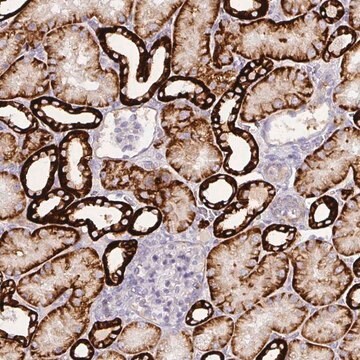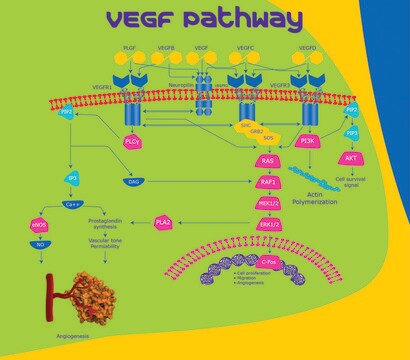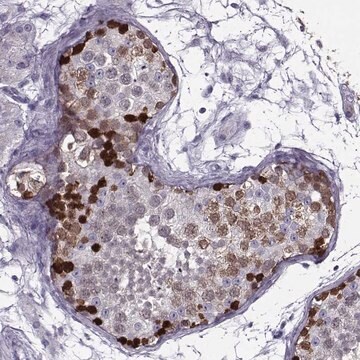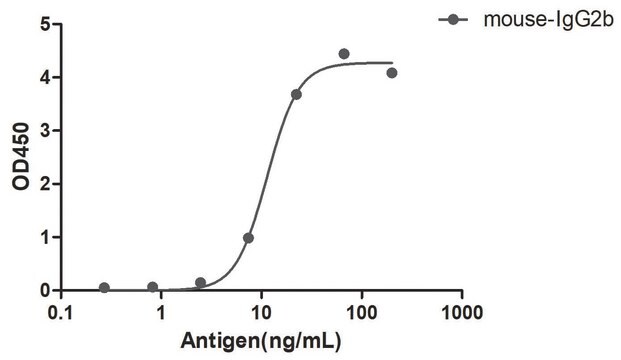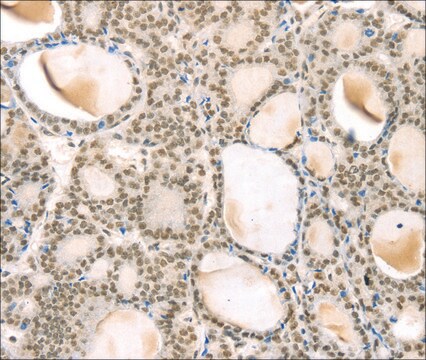추천 제품
생물학적 소스
rabbit
Quality Level
결합
unconjugated
항체 형태
affinity isolated antibody
항체 생산 유형
primary antibodies
클론
polyclonal
제품 라인
Prestige Antibodies® Powered by Atlas Antibodies
양식
buffered aqueous glycerol solution
종 반응성
human
향상된 검증
orthogonal RNAseq
Learn more about Antibody Enhanced Validation
기술
immunofluorescence: 0.25-2 μg/mL
immunohistochemistry: 1:50-1:200
면역원 서열
ACLALNQEQQGQLLEVGWNNTASARNDIQRNLNCCGFRSVNPNDTCLASCVKSDHSCSPCAPIIGEYAGEV
UniProt 수납 번호
배송 상태
wet ice
저장 온도
−20°C
타겟 번역 후 변형
unmodified
유전자 정보
human ... TSPAN13(27075)
일반 설명
TSPAN13 (tetraspanin 13) gene encodes a protein belonging to the transmembrane 4 superfamily, also known as the tetraspanin family of proteins. They are integral membrane proteins characterized by the presence of four transmembrane hydrophobic domains. They are 200-300 amino acid long and contain one small extracellular loop of 13-30 amino acids, a short intracellular sequence, and a second, large extracellular loop. This large loop contains a CCG motif (Cys-Cys-Gly) followed by 2-6 cys residues.
면역원
tetraspanin 13 recombinant protein epitope signature tag (PrEST)
애플리케이션
All Prestige Antibodies Powered by Atlas Antibodies are developed and validated by the Human Protein Atlas (HPA) project and as a result, are supported by the most extensive characterization in the industry.
The Human Protein Atlas project can be subdivided into three efforts: Human Tissue Atlas, Cancer Atlas, and Human Cell Atlas. The antibodies that have been generated in support of the Tissue and Cancer Atlas projects have been tested by immunohistochemistry against hundreds of normal and disease tissues and through the recent efforts of the Human Cell Atlas project, many have been characterized by immunofluorescence to map the human proteome not only at the tissue level but now at the subcellular level. These images and the collection of this vast data set can be viewed on the Human Protein Atlas (HPA) site by clicking on the Image Gallery link. We also provide Prestige Antibodies® protocols and other useful information.
The Human Protein Atlas project can be subdivided into three efforts: Human Tissue Atlas, Cancer Atlas, and Human Cell Atlas. The antibodies that have been generated in support of the Tissue and Cancer Atlas projects have been tested by immunohistochemistry against hundreds of normal and disease tissues and through the recent efforts of the Human Cell Atlas project, many have been characterized by immunofluorescence to map the human proteome not only at the tissue level but now at the subcellular level. These images and the collection of this vast data set can be viewed on the Human Protein Atlas (HPA) site by clicking on the Image Gallery link. We also provide Prestige Antibodies® protocols and other useful information.
생화학적/생리학적 작용
TSPAN13 (tetraspanin 13) gene is found to be up-regulated in cases of prostate cancer and may play a role in its progression. It is also significantly overexpressed in mucinous, clear cell and endometrioid adenocarcinomas of the ovary, testicular germ cell tumors, bladder carcinoma and B-cell acute lymphoblastic leukaemia. It may serve as a potent breast cancer suppressor gene.
특징 및 장점
Prestige Antibodies® are highly characterized and extensively validated antibodies with the added benefit of all available characterization data for each target being accessible via the Human Protein Atlas portal linked just below the product name at the top of this page. The uniqueness and low cross-reactivity of the Prestige Antibodies® to other proteins are due to a thorough selection of antigen regions, affinity purification, and stringent selection. Prestige antigen controls are available for every corresponding Prestige Antibody and can be found in the linkage section.
Every Prestige Antibody is tested in the following ways:
Every Prestige Antibody is tested in the following ways:
- IHC tissue array of 44 normal human tissues and 20 of the most common cancer type tissues.
- Protein array of 364 human recombinant protein fragments.
결합
Corresponding Antigen APREST70133
물리적 형태
Solution in phosphate-buffered saline, pH 7.2, containing 40% glycerol and 0.02% sodium azide.
법적 정보
Prestige Antibodies is a registered trademark of Merck KGaA, Darmstadt, Germany
면책조항
Unless otherwise stated in our catalog or other company documentation accompanying the product(s), our products are intended for research use only and are not to be used for any other purpose, which includes but is not limited to, unauthorized commercial uses, in vitro diagnostic uses, ex vivo or in vivo therapeutic uses or any type of consumption or application to humans or animals.
적합한 제품을 찾을 수 없으신가요?
당사의 제품 선택기 도구.을(를) 시도해 보세요.
Storage Class Code
10 - Combustible liquids
WGK
WGK 1
Flash Point (°F)
Not applicable
Flash Point (°C)
Not applicable
가장 최신 버전 중 하나를 선택하세요:
Peng Li et al.
Bosnian journal of basic medical sciences, 19(2), 146-154 (2018-08-17)
Previous studies demonstrated dysregulation of different microRNAs in thyroid cancer. Tetraspanins (TSPANs) are cell surface proteins with critical roles in many cellular processes, and implications in tumor development. Here we investigated the role of miR-369-3p in papillary thyroid cancer (PTC)
Liejun Jiang et al.
Clinical and experimental medicine, 19(3), 377-384 (2019-04-21)
Tetraspanins have been implicated in multiple biological functions including protein networking and cell signaling. NET-6 (TSPAN 13) has been demonstrated to be a tumor suppressor gene in breast cancer, while CD151 is more likely to act as an oncogene. However
Huayi Huang et al.
Journal of cancer research and clinical oncology, 133(10), 761-769 (2007-05-09)
NET-6 is a largely uncharacterized member of the tetraspanin superfamily. We have recently shown that its expression level was lowest in breast carcinomas with aggressive characteristics. We now describe the phenotypic and molecular changes induced in MDA-MB-231 breast carcinoma cells
Antonio Garcia-España et al.
Genomics, 91(4), 326-334 (2008-02-23)
A detailed phylogenetic analysis of tetraspanins from 10 fully sequenced metazoan genomes and several fungal and protist genomes gives insight into their evolutionary origins and organization. Our analysis suggests that the superfamily can be divided into four large families. These
Jose M Arencibia et al.
International journal of oncology, 34(2), 457-463 (2009-01-17)
Prostate cancer is one of the most frequent malignancies in the Western world. The identification of additional molecular markers is needed to refine the diagnosis of prostate cancer and to develop more effective therapies. In order to identify molecular abnormalities
자사의 과학자팀은 생명 과학, 재료 과학, 화학 합성, 크로마토그래피, 분석 및 기타 많은 영역을 포함한 모든 과학 분야에 경험이 있습니다..
고객지원팀으로 연락바랍니다.
